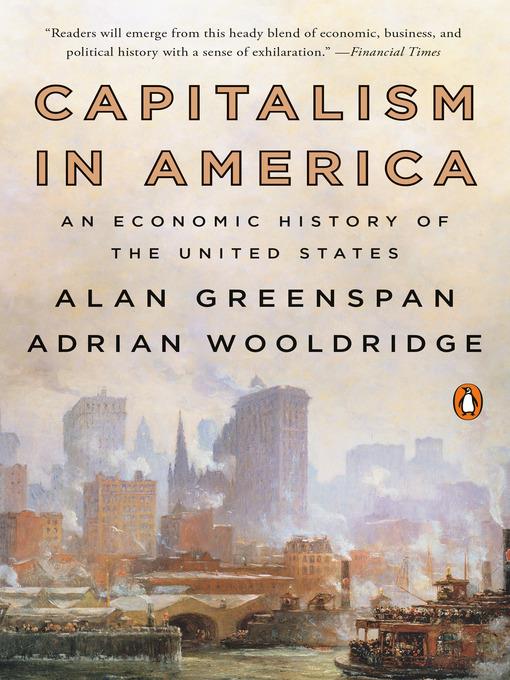
Capitalism in America
An Economic History of the United States
کتاب های مرتبط
- اطلاعات
- نقد و بررسی
- دیدگاه کاربران
نقد و بررسی

August 13, 2018
Former Federal Reserve chairman Greenspan and Economist political editor Wooldridge set out to recount how the United States rose to become “the mightiest economy the world has ever seen” and explain the puzzling economic slowdown that has reared its head in the past decade. Unlike its Old World rivals, they write, America didn’t just grow rich; it churned out innovation, embracing the Schumpeterian process of “creative destruction” and allowing entrepreneurial individuals to fulfill their potential in a society where hard work was prized, newcomers encouraged, and property rights safeguarded. The authors provide a predictably triumphalist reading of the growth of American capitalism, with progressive reformers described as in thrall to the “cult of government” and late-19th-century steel barons lauded as serving the public good. In conclusion, they recommend two fixes for our current economic woes: entitlements reform and more prudent reserves ratios at big banks in order to prevent another financial collapse. Consistently engaging and packed with fun facts (an 1870s guide to barbed wire listed 749 varieties of the fencing that won the West), the book speeds along at high velocity, pausing only to extol the virtues of American democracy and capitalism—which, for the authors, are essentially the same thing. This book will hold no surprises for those familiar with Greenspan’s career.

August 15, 2018
Everyone's favorite Randian economist explains the rise of American economic supremacy and worries for its passing.Former Federal Reserve chair Greenspan (The Map and the Territory: Risk, Human Nature, and the Future of Forecasting, 2013, etc.) teams up with Economist political editor Wooldridge (co-author: The Fourth Revolution: The Global Race to Reinvent the State, 2014, etc.) to chronicle the emergence of the United States from economic backwater to powerhouse, with its 5 percent of the world's population accounting for 25 percent of its GDP. By the authors' account, this rise has several key components, including diversity, equal opportunity to enter a marketplace with few barriers to entry, and an openness to contribution from just about everyone--the farmer's son Henry Ford, for instance, who toured the great slaughterhouses of Chicago and marveled at the carcasses moving through the saws and trimmers: "It was during a visit to one of these abattoirs that Henry Ford got the idea of the mass assembly line." Though of a libertarian bent, Greenspan and Wooldridge seemingly approve of public goods in the form of education, which, among other things, has long allowed the U.S. to be a "talent magnet" for entrepreneurially minded immigrants; now, events inspire them to decry "the current rise of nativism and populism." Rather more predictably, the authors lament the rise of regulation. "In the 1930s," they write, "Americans turned to government to save them from the instability of the market. In the 1980s, they turned to entrepreneurs to save them from the suffocation of government." The current regulation-heavy environment, coupled with lack of innovation and misguided efforts to place barriers on free trade, may lead to the emergence of rivals better attuned to the global market. Meanwhile, the authors foresee the beginnings of stagflation and the eventual economic decline of the once peerless U.S. market.Not without biases, but a smart and engaging look at the workings of the economic machine under various regimes, isolationist and internationalist alike.
COPYRIGHT(2018) Kirkus Reviews, ALL RIGHTS RESERVED.

Starred review from October 1, 2018
This illuminating and in-depth history by former federal reserve chairman Greenspan and journalist Wooldridge (The Economist) describes the unique conditions that propelled the United States to evolve from humble beginnings into a dynamic economic powerhouse. This book is a valuable contribution to U.S. business history because it explains financial events and the culture of innovation from macroeconomic perspectives and offers remarkable insights into the current business climate. The authors attempt to answer the question of whether the U.S. will keep its world economic supremacy. Although this collaborative project is fairly lengthy, the engaging writing style will appeal to many readers, especially those with a desire understand better past events as well as readers seeking knowledge about how economists develop forecasts. Each of the 12 chapters includes a helpful summary. VERDICT Strongly recommended for all academic and public library business collections.--Caroline Geck, Somerset, NJ
Copyright 2018 Library Journal, LLC Used with permission.

October 1, 2018
Greenspan, former chair of the Federal Reserve Board, joins with Economist political editor Wooldridge to explain how a bunch of contentious colonies rose to become a powerhouse of wealth and innovation. With a special focus on Greenspan's big interest, productivity growth.
Copyright 2018 Library Journal, LLC Used with permission.

























دیدگاه کاربران